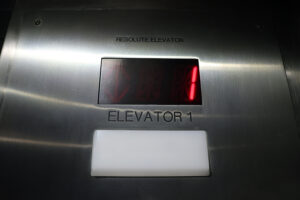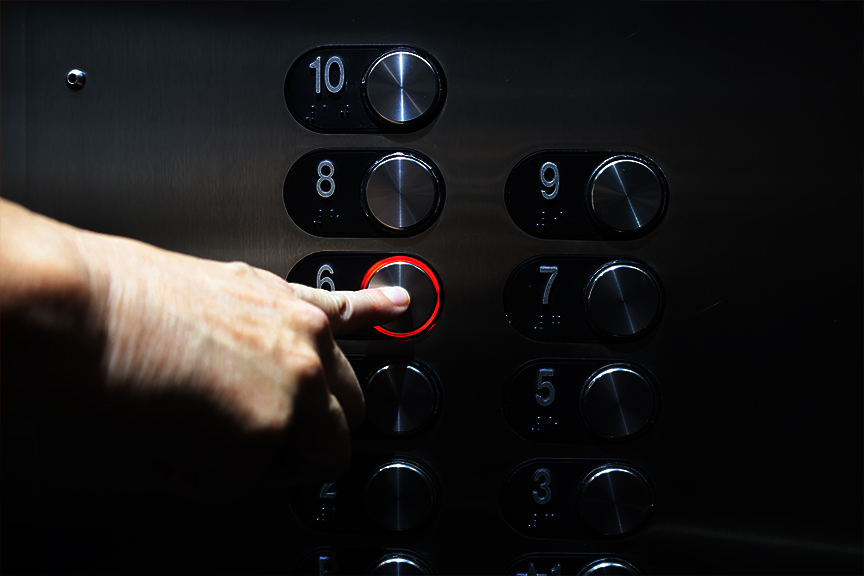 Elevators per building. Talk about a tricky subject! Few try to tackle it in a blog because no matter what is written, there will be people that take exception. You may ask, why is this not just some simple formula with occupancy numbers, building type and square feet? Because it is more complex than that as you will see below.
Elevators per building. Talk about a tricky subject! Few try to tackle it in a blog because no matter what is written, there will be people that take exception. You may ask, why is this not just some simple formula with occupancy numbers, building type and square feet? Because it is more complex than that as you will see below.
Don’t worry I will get to rough numbers to help guide you on your project, but with a few caveats. The most important being, a qualified elevator consultant can be a huge help in this area. Consider finding the right one. Now on to the things that you should consider when making the determination of how many elevators per building.
First in Last Out
The number of elevators per building needed has a lot to do with many factors that may not be known when a building is in the planning stages however, the first thing that gets dropped into the architect’s plans are the ways to go up and down in a building; elevators and stairs. So do your best with the list below so you can take the rough numbers I am providing and tweak them closer to your needs.
Here are the things to consider:
- Elevator use. Just people going to work is one thing. Furniture is another. Don’t make the mistake of getting too small a unit. The capacity an elevator has (larger loads) can change the number you may need. One for passengers and one for heavy items.
- Who is going to be using the elevator? An elevator that just meets ADA requirements is too small for a gurney. The DJ and caterers going to an upstairs dance hall will need more capacity and apartment complexes may need a larger/taller elevator cab for couches and mattresses. Think seriously about use.
- Total number of floors. That goes without saying.
- Overall travel distance and travel distance between floors. You can have two floors a hundred feet apart in travel distance. That would require more speed. The opposite is multiple stops close together where the elevator speed is less important than how fast it levels. The elevator may never reach full speed at all in many small rise applications.
- What is a reasonable wait time? Some buildings like hotels and offices want a total wait time as close to 25 seconds as possible. Apartments can have a time of up to a minute. Are you willing to pay more to keep that number smaller? Adding elevators will drop the total wait time.
- Peak times of use will always slow people down. Will you be willing to foot the bill for another elevator to handle heavy traffic flow in mornings and evenings? Do you have peak times at all?
- Will there be a known traffic pattern? For instance the world’s fastest elevator only travels from the ground floor to a hotel lobby 95 stories up. It was built to accommodate a known traffic pattern. Likewise a restaurant on the top floor may require an additional elevator.
- Square feet of the floors. If a building is very small, the footprint of the elevator may eat up more space than practical and the distance to walk from the elevator to an apartment will also be short. In a hotel with multiple wings, many elevators may be needed to reduce the distance from the elevator to the furthest rooms.
- Building codes! These are more influential than most of the above. You must know what is allowed and what is required in your city, state, county or other jurisdiction. It is important to know that a state can have a different code than some cities in that state.
All of the above will ultimately influence your decision making process. Just keep in mind the point is to serve the maximum number of people with the most minimal waiting time at the highest peaks of usage to disperse the population as fast as possible.
Promise Made – Promise Kept
So with all that stuff to consider, here are rough (emphasis on rough) numbers for elevators per building I promised. I use this general list when talking to people about elevator needs. Remember to be nice when you respond to this blog. Keep in mind that these are very rough number to consider.
Office buildings:
- One elevator for approximately 50,000 square feet of building in use. For every two floors or two and a half floors consider adding one more elevator. A four or five floor building probably needs two elevators.
- Try not to exceed eight total elevators in a single grouping. No group of elevators should serve more than 16 or more floors.
- Consider a special service elevator if you are going over four floors. Housekeeping, maintenance, security, etc. When you get closer to ten it is probably a must logistically.
- Remember some special floors may increase the number of elevators. A common lunchroom or shopping area contained on a separate floor from the others may force the need for another elevator due to traffic patterns.
Hotels:
- Provide one elevator for every 75 rooms or so with a minimum of one elevator up to three floors and add one more for four floors. Don’t go past 150 feet from farthest room to elevator.
- As you build up and add rooms, remember to add elevators per every 75 rooms.
- To help room service and maid service add a service elevator for every two passenger elevators.
- Ballrooms, meeting rooms, or expanded lobby areas above the entry level can increase the number of elevators.
Apartments / Condos / Dormitories:
- There should be one elevator for every 90 units. A maximum of 150 feet from the elevator to the farthest elevator is a must.
- City apartments and really high priced units can require an elevator for every 50 – 60 units to cut wait time.
- If you have penthouse rooms or restaurants a dedicated elevator maybe needed. Remember the need for access and security.
- Always have an elevator with higher ceilings (9 feet) and higher weight capacity (3500 lbs) for moving furniture and heavy items.
- If you are over 10 floors, a service elevator or small freight elevator should be considered.
- For four stories or more above grade a gurney sized elevator is required. Remember always check codes before you decide on number of elevators.
Medical Facilities:
- In buildings with significant staff and visitor traffic, consider separate passenger elevators for staff and patients.
- Two patient elevators at a minimum for multi-story medical facilities and one additional elevator for every 100 beds.
- Additional elevators may be required if visitor areas are on higher floors. This is often dependent on the location of the medical facility and overall travel distance.
- Dirty elevators maybe required or needed. Moving medical waste sometimes requires a special elevator.
- Additional elevators may be required if operating areas, cafeterias, laundry, central supplies, etc. are on upper levels.
Consider what each area of the medical facility is doing and where each elevator stops. - You don’t necessarily need a hospital bed-sized elevators throughout the facility.
Conclusion
Again, this is my personal cheat sheet for elevators per building based upon our research and experience. But, keep in mind that these numbers can and will change based upon the factors above and other variables not listed or not even thought of yet. The elevator world is still grappling with large mixed use projects that incorporate several of the above categories into one facility. So be thoughtful, ask plenty of questions and if you need the help contact us or a qualified consultant.


Hello,
Based on five decades of personal experience as a Vertical Transportation Consultant your “cheat sheet” is pretty good overall as a point of departure.
That said your basic 1 office passenger elevator per 50,000 SF is a rule of thumb from the 70’s when population density was much less and developers had a much better idea of the type of tenancy they were targeting. In today’s market, it’s better to use about 225 persons per elevator. This metric accounts for variations in floor plate area and population density.
One other thing to add to you cheat sheet is the requirement for two “Fire Service Access Elevators” as of about the 2019 ASME CODE.
Lastly, there are numerous instances when service elevators in any type of building, particularly health care, where these elevators need to be designed for a minimum Class C3 loading or even a Class C1 loading.
Thank you! Love your response and thanks for the pointers on updating some of my categories. Like I said it is important to get a consultant. But as you know some folks put the boxes in the drawings before the consultant is even contacted. It was great to hear from you!